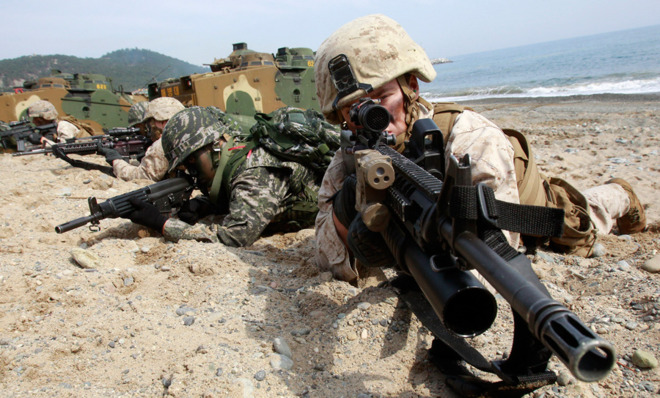How U.S. special forces are preparing for the worst-case scenario in North Korea
They might be the first ones tasked with stepping across the DMZ one day


Every year, the U.S. and South Korea team up for one of the world's largest military exercises. Thousands of troops backed by fighter aircraft, strategic bombers, and Navy warships plan for the worst.
But America's elite Special Operations Forces are also involved — planning for the day when they might be the first ones tasked with stepping across the DMZ.
The training is a less publicized element of the Pentagon's exercises in South Korea, which are emphasized as defensive in nature. But for three days in April 2013, American commandos carried out simulated North Korea missions during Balance Knife 13-1 — part of the much larger Foal Eagle exercise — near Iksan and Damyang, South Korea.
The Week
Escape your echo chamber. Get the facts behind the news, plus analysis from multiple perspectives.

Sign up for The Week's Free Newsletters
From our morning news briefing to a weekly Good News Newsletter, get the best of The Week delivered directly to your inbox.
From our morning news briefing to a weekly Good News Newsletter, get the best of The Week delivered directly to your inbox.
Along with the 7th and 11th ROK Special Forces Brigades, the exercise involved two American commando groups of 12 men each — Operational Detachment Alphas 1336 and 1333. Both American teams belonged to Charlie Company, 3rd Battalion of the 1st Special Forces Group.
Notably, the training dealt with how to move special operators into and out of North Korea, according to a review published in the January edition of Special Warfare, the wonky, academic journal of the Army's John F. Kennedy Special Warfare Center and School. The scenario also dealt with how to grow an "indigenous resistance organization" inside the North.
For one, many South Korean commandos "still have family in the North that they may or may not have contact with," the review stated. That's good for building "strong relationships that transcend NK ideology and can serve as a foundation for the development of a loyal resistance organization."
The U.S. maintains a force in South Korea of more than 28,000 soldiers, sailors, airmen, and Marines. But if anything, the training showed just how unfamiliar the Korean Peninsula is to the forces expected to deploy from elsewhere, in the event of a crisis.
A free daily email with the biggest news stories of the day – and the best features from TheWeek.com
Experience in "Iraq, Afghanistan and the Philippines has brought to light the need for an aggressive course correction if U.S. forces ever hope to successfully execute UW operations as a strategic option in the KTO," the article stated, using acronyms for unconventional warfare and the Korean Theatre of Operations.
In a nutshell, everything commandos do becomes harder. The North Koreans have better tools for intercepting communications than the Taliban, so troops have to enforce stricter radio silence. The result? A "drastic reduction in battle command capability."
The North Koreans have a "robust Air Defense Artillery threat" limiting where helicopters can travel and land. The country is heavily deforested, meaning almost all movement across the border will have to be done at night.
North Korea is also relatively small compared to Afghanistan, and underdeveloped infrastructure in the mountains means even a tiny North Korean force would be able to set up a checkpoint watching over large areas, impeding the commandos and their resistance fighter allies from moving around. Thus, troops would move largely by foot.
"If that movement in a denied area with an indigenous resistance force results in enemy contact," Special Warfare warned, "then assets such as a quick reaction force and readily available indirect fires and close-air support will be the exception rather than the rule."
Another problem is getting the wounded out. Medical evacuation crews flying to a wounded soldier in Afghanistan takes an average of 42 minutes. But in North Korea, days or even a week might be more realistic — putting more responsibilities onto the medic.
"During the initial-entry stage in the KTO, the movement of wounded personnel will be from inside a denied area, across a border, to a secure area by clandestine means," the report noted.
There's a caveat. None of this means the U.S. would back an anti-Pyongyang insurgency. Military exercises play highly in North Korean propaganda as evidence of plans to attack. But for the Pentagon, the exercises are mainly a means to practice deploying troops to South Korea in a hurry — in the event of hostilities spiraling out of control, the collapse of the North Korean regime or a refugee crisis.
In recent years, the exercises have also focused on smaller scenarios like a sudden but limited North Korean assault similar to the artillery shelling of Yeonpyeon island in 2010. It's worth noting South Korea retaliated with artillery fire after that attack, but was discouraged from launching air strikes by the White House, former Defense Secretary Robert Gates revealed in his memoir. Had South Korea carried out air strikes, the situation "could escalate dangerously," Gates wrote.
Nevertheless, the Pentagon prefers to stress the defensive nature of the exercises aimed at blunting a North Korean provocation. But if Balance Knife is any indication, it's not entirely defensive. North Korea has also become shakier since Kim Jong Un assumed power in Pyongyang, including purging much of the senior military command.
The exercises, in a way, reflect the unpredictability of the peninsula — and North Korea's actions. America's elite troops are preparing for the worst-case scenario, just in case.
From drones to AKs, high technology to low politics, War is Boring explores how and why we fight above, on, and below an angry world. Sign up for its daily email update here or subscribe to its RSS Feed here.
More from War is Boring...
-
 Political cartoons for January 4
Political cartoons for January 4Cartoons Sunday's political cartoons include a resolution to learn a new language, and new names in Hades and on battleships
-
 The ultimate films of 2025 by genre
The ultimate films of 2025 by genreThe Week Recommends From comedies to thrillers, documentaries to animations, 2025 featured some unforgettable film moments
-
 Political cartoons for January 3
Political cartoons for January 3Cartoons Saturday's political cartoons include citizen journalists, self-reflective AI, and Donald Trump's transparency